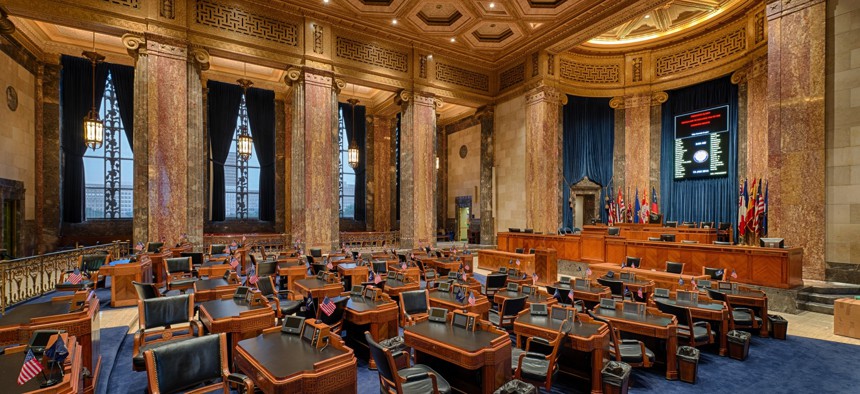A Closer Look at Louisiana’s Grim Budget and Economic Numbers

The Louisiana State Senate Chamber in Baton Rouge. \Nagel Photography / Shutterstock.com
Revenues, general fund balances, unemployment rates and GDP are all downbeat in the Pelican State.
Tax revenues from corporations, sales and individual income were among those that saw the biggest drops in a pessimistic state budget forecast Louisiana officials adopted Wednesday.
Revised estimates lowered the state’s overall amount of projected general fund revenues by about $570 million in the current fiscal year, which ends June 30. In other words, money from taxes and other sources Louisiana planned on having to pay its bills for the year is expected to fall short by over a half-billion dollars.
Contributing to the total figure were reductions of $228.8 million in corporate income and franchise taxes, $167.4 million in general sales taxes and $71.9 million in individual income taxes, according to documents outlining the adopted estimates.
These and other numbers that offer a window into the state’s finances and economy, provide a look at the difficulties up against Gov. John Bel Edwards—who is about one month into his first term—and state lawmakers, as they seek to remedy massive budget gaps.
When combined with other shortfalls, the lower revenue projections mean Louisiana’s budget deficit is now pegged around $870 million in the current fiscal year. A roughly $2 billion gap is anticipated in 2016-17. To address the budget problems, Edwards, a Democrat, has called for a special legislative session that will begin later this week.

Edwards’ Republican predecessor in the Governor’s Mansion, Bobby Jindal, faced objections to his administration’s tax and budgeting policies. Some critics say these policies relied on gimmicks, rather than sustainable revenue sources, to balance the state's budget, and are part of what has led to Louisiana’s current fiscal woes.
Cratering oil prices have exacerbated recent revenue shortfalls. The energy sector is an important part of Louisiana’s economy and the industry’s downturn has negatively affected a number of the state's income streams, such as corporate taxes.
“I’ve never seen corporate numbers this weak,” Greg Albrecht, a chief economist in Louisiana's Legislative Fiscal Office told officials on the state's revenue forecasting panel Wednesday.
But he stressed that factors other than oil are in play.
For instance, he said “skyrocketing” currency exchange rates are putting a dent in bulk chemical exports out of Louisiana. Later Albrecht noted: “Sales tax is stagnating. We haven’t had a decent sales tax year, one maybe, out of the past five years, and it’s a 30 percent share of our total state tax receipts.”
“It has almost, apparently, no growth potential to it,” he added.
Manfred Dix, chief economist in the state's Office of Planning and Budget, also spoke to the panel on Wednesday.
“There is weakness all around in the economy,” he said.
As revenues sputter, the state’s general fund balance has declined.
“The revenue is not coming in,” John Broussard, chief investment officer for the Louisiana Department of the Treasury, said Wednesday as he discussed the pool of investments that makes up the fund. “We’re having less and less and less to invest. So our ability to fund the deficit becomes limited as the investment pool dwindles.”
“In my experience, during my tenure,” he added, “this is probably the longest we’ve gone with a negative cash flow.”
The general fund acts as the state’s primary budget account for operating expenses, and was set to include about $9 billion in expenditures throughout the 2015-16 fiscal year.
A report from the Louisiana Department of the Treasury shows that between October and January, general fund month-end balances have been negative by amounts ranging from $1.6 billion, to $1.8 billion.
The state has been backfilling the fund by borrowing from other parts of the budget.

But a treasury official said Wednesday that, since around October, Louisiana has only had about a $1 billion buffer available before it will reach the maximum that can be borrowed from other funds.
Beyond the budget there are other troubling figures confronting the state.
Louisiana’s seasonally adjusted unemployment rate in December was 6.1 percent, according to the U.S. Bureau of Labor Statistics. That’s down from 7.2 percent in December 2014, but higher than the December 2015 national unemployment rate, which was 5 percent.

The number of jobs in Louisiana industries that support the mining sector, which includes gas and oil extraction, fell from about 40,800 in July of 2014 to 33,900 in December 2015, according to Bureau of Labor Statistics data.

Gross domestic product, a key indicator of a place’s economic strength, grew by 2.4 percent in the state during the second quarter of 2015, figures from the U.S. Bureau of Economic Analysis show.

That number is not very impressive when contrasted with the rest of the country.
Compared to other states, Louisiana ranked 42nd in terms of GDP growth in the second quarter of last year. Across the southeast nine states had growth rates that outpaced Louisiana’s. The only states in the region with lower rates were Alabama and West Virginia.
Louisiana's special legislative session is set to begin Sunday, Feb. 14.
Bill Lucia is a Reporter for Government Executive’s Route Fifty.
NEXT STORY: At the Illinois State Capitol, Obama Eschews the ‘Refusal to Compromise as an Accomplishment’






